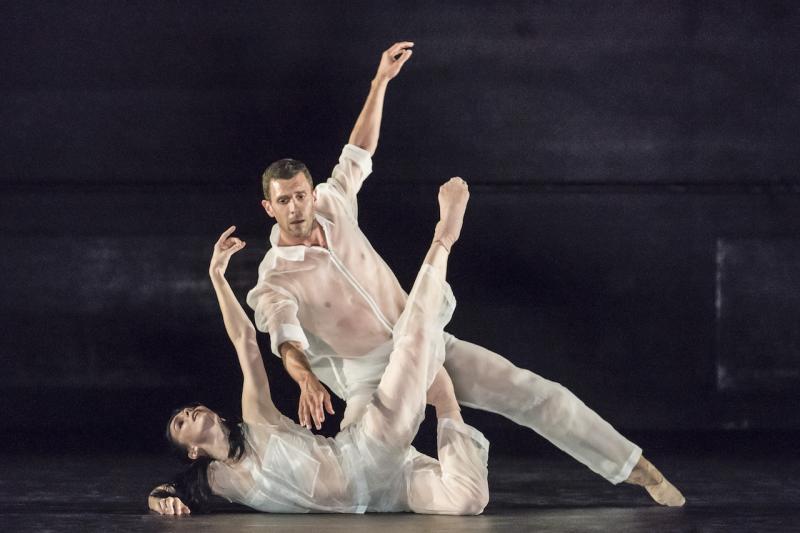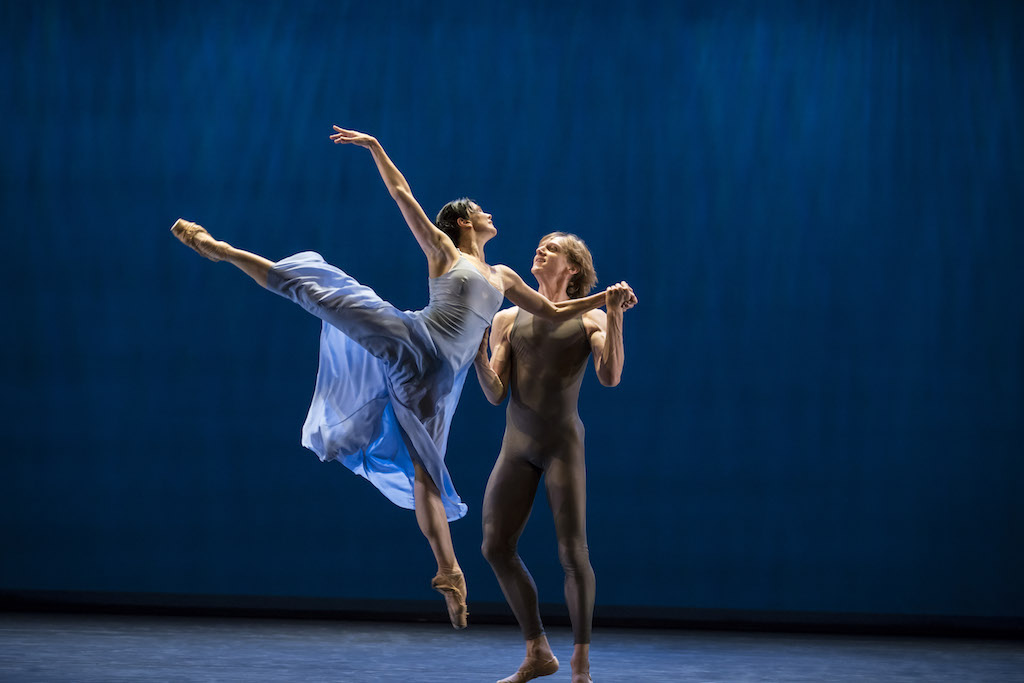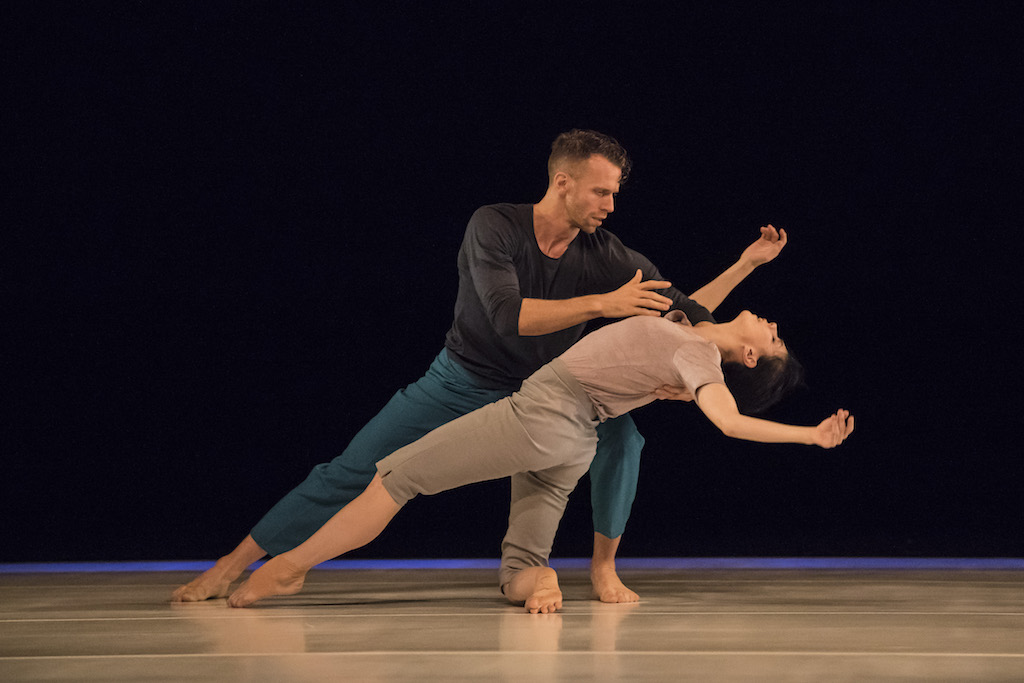Natalia Osipova: Pure Dance, Sadler's Wells review - a great ballerina branches out, again | reviews, news & interviews
Natalia Osipova: Pure Dance, Sadler's Wells review - a great ballerina branches out, again
Natalia Osipova: Pure Dance, Sadler's Wells review - a great ballerina branches out, again
This off-piste excursion is no vanity project

Sometimes a dance talent arrives that causes the ground to shift and alters the landscape. Natalia Osipova is one such. Not content to be queen of all she surveys at the Royal Ballet, she is hungry for new territory.
Of course this is not the first time a great ballet dancer has turned to contemporary dance. Mikhail Baryshnikov and then Sylvie Guillem famously added more than a decade to their performing careers by embracing a new way of moving. But Osipova isn’t looking to put less strain on her hip joints. Far from it. At 33 she’s at her physical peak and clearly wants to set new challenges for her body and brain, to see how far off-piste she can take them. Significantly, not one of the six pieces she takes on in this programme gives her an easy ride, not even to give her a breather. Not all of the choreographic choices come off well, but one thing is certain – this is no vanity project.
 Perhaps to reassure her public, she bookends the programme with two pieces of modern classicism, Antony Tudor’s wistful The Leaves Are Fading and Alexei Ratmansky’s Valse Triste. Commissioned by Osipova from her former boss at the Boshoi, the latter is the more full-bloodied and suits her dramatic temperament. The inclusion of some classical has the bonus of giving fans a closer look at Osipova’s burgeoning dance partnership with David Hallberg, the beauteous American who joins the Royal as a principal guest artist this season. Pictured above, they are indeed a compelling pairing: light and dark; ice and fire.
Perhaps to reassure her public, she bookends the programme with two pieces of modern classicism, Antony Tudor’s wistful The Leaves Are Fading and Alexei Ratmansky’s Valse Triste. Commissioned by Osipova from her former boss at the Boshoi, the latter is the more full-bloodied and suits her dramatic temperament. The inclusion of some classical has the bonus of giving fans a closer look at Osipova’s burgeoning dance partnership with David Hallberg, the beauteous American who joins the Royal as a principal guest artist this season. Pictured above, they are indeed a compelling pairing: light and dark; ice and fire.
Valse Triste starts out as an amusingly old-fashioned waltz, almost tongue-in-cheek romantic, set to unfamiliar music by Sibelius. The mood gradually darkens as the woman is stricken by bouts of doubt, anxiety and ultimately what looks like a wish to self-destruct in a series of increasingly desperate dives. Hallberg makes an effective if initially reluctant life saver. With the dramatic tension of an Ibsen tragedy packed into six minutes, it is superb.
 Other duets on the bill lack that concision, sometimes losing the audience in their meanderings. Israeli choreographer Roy Assaf’s Six Years Later – performed with Osipova’s real-life partner Jason Kittelberger (pictured above) – almost grinds to a halt several times although its premise – an ex-couple raking over the coals – throws up some fascinating ideas. At one point the pair biff one other with alternate shoulders so long and so hard that it looks as if it’s meant to hurt. Another sequence sees them united in a rather beautiful knotting and unknotting of forearms, repetition pushed to a point where an apparently loving gesture starts to look masochistic. Like memory itself, Six Years Later is a mixture of snapshots and lacunae, with little continuity. When the pair stop to chat for several minutes, a cheesy pop song drowning them out, it feels as if you’ve stumbled in on a rehearsal, not a performance at all. This is dance that stretches the very definition of dance.
Other duets on the bill lack that concision, sometimes losing the audience in their meanderings. Israeli choreographer Roy Assaf’s Six Years Later – performed with Osipova’s real-life partner Jason Kittelberger (pictured above) – almost grinds to a halt several times although its premise – an ex-couple raking over the coals – throws up some fascinating ideas. At one point the pair biff one other with alternate shoulders so long and so hard that it looks as if it’s meant to hurt. Another sequence sees them united in a rather beautiful knotting and unknotting of forearms, repetition pushed to a point where an apparently loving gesture starts to look masochistic. Like memory itself, Six Years Later is a mixture of snapshots and lacunae, with little continuity. When the pair stop to chat for several minutes, a cheesy pop song drowning them out, it feels as if you’ve stumbled in on a rehearsal, not a performance at all. This is dance that stretches the very definition of dance.
Contemporary dancer Jonathan Goddard is Osipova’s Third Man, as it were, though his talents are woefully underused in Flutter, by Ivan Perez, another loose, experimental number. Larking about in a patch of light, the couple repeatedly run off into the dark, giggling like children. Some will question why a ballerina at the peak of her powers would want to engage in stuff like this. The answer is there in the question. She’s at the peak of her considerable powers, so why not?
- Natalia Osipova: Pure Dance at Sadler’s Wells until 25 October
- Read more dance reviews on theartsdesk
rating
Explore topics
Share this article
The future of Arts Journalism
You can stop theartsdesk.com closing!
We urgently need financing to survive. Our fundraising drive has thus far raised £49,000 but we need to reach £100,000 or we will be forced to close. Please contribute here: https://gofund.me/c3f6033d
And if you can forward this information to anyone who might assist, we’d be grateful.

Subscribe to theartsdesk.com
Thank you for continuing to read our work on theartsdesk.com. For unlimited access to every article in its entirety, including our archive of more than 15,000 pieces, we're asking for £5 per month or £40 per year. We feel it's a very good deal, and hope you do too.
To take a subscription now simply click here.
And if you're looking for that extra gift for a friend or family member, why not treat them to a theartsdesk.com gift subscription?
more Dance
 'We are bowled over!' Thank you for your messages of love and support
Much-appreciated words of commendation from readers and the cultural community
'We are bowled over!' Thank you for your messages of love and support
Much-appreciated words of commendation from readers and the cultural community
 iD-Reloaded, Cirque Éloize, Marlowe Theatre, Canterbury review - attitude, energy and invention
A riotous blend of urban dance music, hip hop and contemporary circus
iD-Reloaded, Cirque Éloize, Marlowe Theatre, Canterbury review - attitude, energy and invention
A riotous blend of urban dance music, hip hop and contemporary circus
 How to be a Dancer in 72,000 Easy Lessons, Teaċ Daṁsa review - a riveting account of a life in dance
Michael Keegan-Dolan's unique hybrid of physical theatre and comic monologue
How to be a Dancer in 72,000 Easy Lessons, Teaċ Daṁsa review - a riveting account of a life in dance
Michael Keegan-Dolan's unique hybrid of physical theatre and comic monologue
 A Single Man, Linbury Theatre review - an anatomy of melancholy, with breaks in the clouds
Ed Watson and Jonathan Goddard are extraordinary in Jonathan Watkins' dance theatre adaptation of Isherwood's novel
A Single Man, Linbury Theatre review - an anatomy of melancholy, with breaks in the clouds
Ed Watson and Jonathan Goddard are extraordinary in Jonathan Watkins' dance theatre adaptation of Isherwood's novel
 Peaky Blinders: The Redemption of Thomas Shelby, Rambert, Sadler's Wells review - exciting dancing, if you can see it
Six TV series reduced to 100 minutes' dance time doesn't quite compute
Peaky Blinders: The Redemption of Thomas Shelby, Rambert, Sadler's Wells review - exciting dancing, if you can see it
Six TV series reduced to 100 minutes' dance time doesn't quite compute
 Giselle, National Ballet of Japan review - return of a classic, refreshed and impeccably danced
First visit by Miyako Yoshida's company leaves you wanting more
Giselle, National Ballet of Japan review - return of a classic, refreshed and impeccably danced
First visit by Miyako Yoshida's company leaves you wanting more
 Quadrophenia, Sadler's Wells review - missed opportunity to give new stage life to a Who classic
The brilliant cast need a tighter score and a stronger narrative
Quadrophenia, Sadler's Wells review - missed opportunity to give new stage life to a Who classic
The brilliant cast need a tighter score and a stronger narrative
 The Midnight Bell, Sadler's Wells review - a first reprise for one of Matthew Bourne's most compelling shows to date
The after-hours lives of the sad and lonely are drawn with compassion, originality and skill
The Midnight Bell, Sadler's Wells review - a first reprise for one of Matthew Bourne's most compelling shows to date
The after-hours lives of the sad and lonely are drawn with compassion, originality and skill
 Ballet to Broadway: Wheeldon Works, Royal Ballet review - the impressive range and reach of Christopher Wheeldon's craft
The title says it: as dancemaker, as creative magnet, the man clearly works his socks off
Ballet to Broadway: Wheeldon Works, Royal Ballet review - the impressive range and reach of Christopher Wheeldon's craft
The title says it: as dancemaker, as creative magnet, the man clearly works his socks off
 The Forsythe Programme, English National Ballet review - brains, beauty and bravura
Once again the veteran choreographer and maverick William Forsythe raises ENB's game
The Forsythe Programme, English National Ballet review - brains, beauty and bravura
Once again the veteran choreographer and maverick William Forsythe raises ENB's game
 Sad Book, Hackney Empire review - What we feel, what we show, and the many ways we deal with sadness
A book about navigating grief feeds into unusual and compelling dance theatre
Sad Book, Hackney Empire review - What we feel, what we show, and the many ways we deal with sadness
A book about navigating grief feeds into unusual and compelling dance theatre
 Balanchine: Three Signature Works, Royal Ballet review - exuberant, joyful, exhilarating
A triumphant triple bill
Balanchine: Three Signature Works, Royal Ballet review - exuberant, joyful, exhilarating
A triumphant triple bill

Add comment